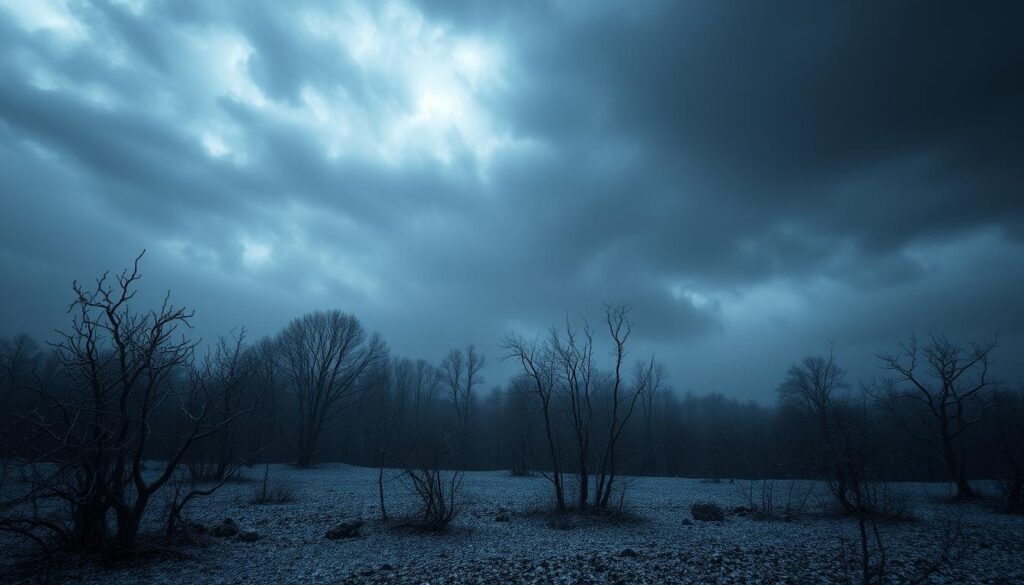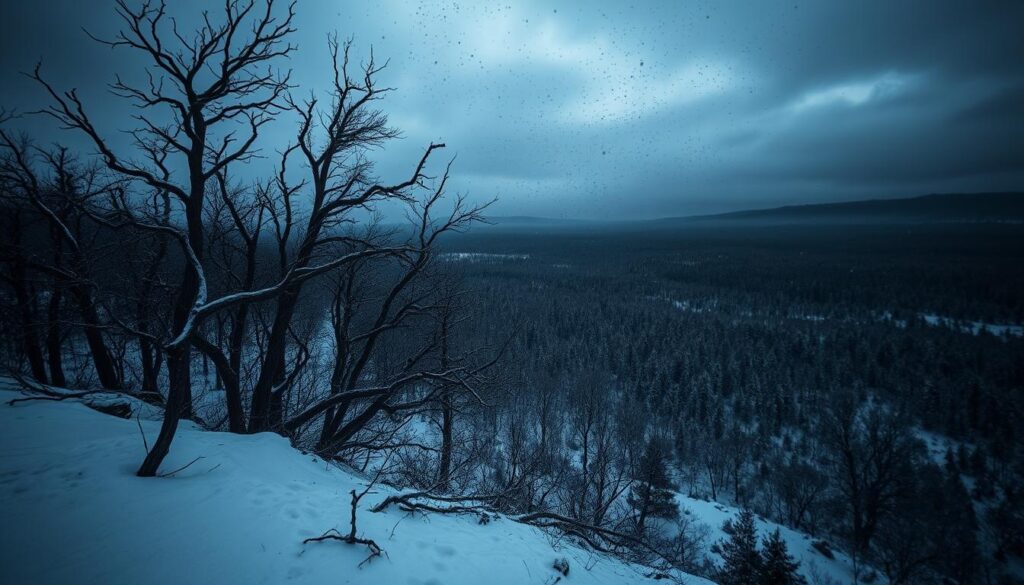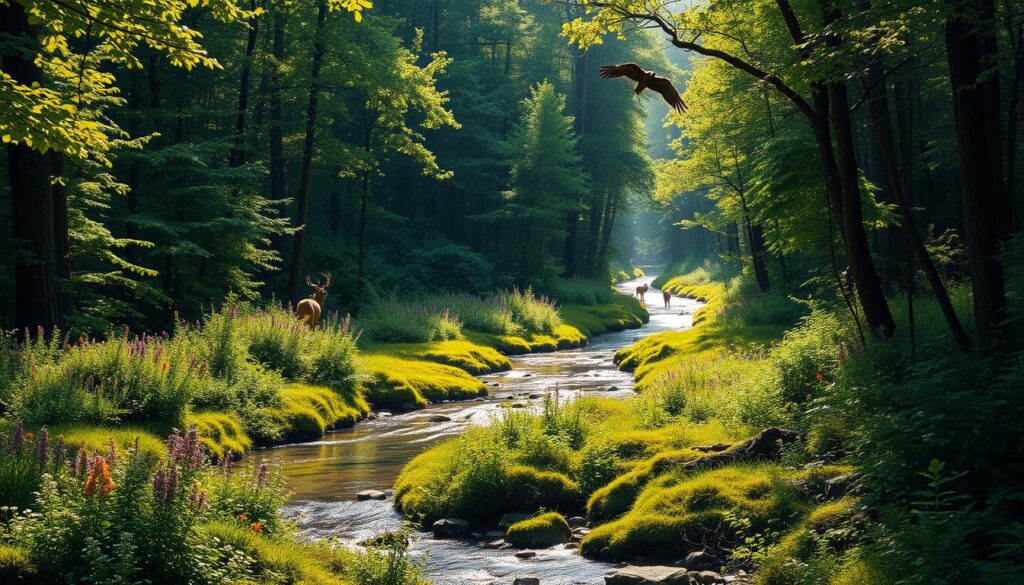
black snow falling. This rare event is not just unexpected but also sparks curiosity about its causes and effects. It shows how complex and unpredictable our planet’s climate can be.
As we explore black snow, we’ll uncover the science behind it. We’ll also look at how it connects to our changing weather patterns. This includes the impact of mysterious weather events.
Understanding black snow and its link to summer weather is key to grasping our planet’s climate. By studying the factors that lead to black snow, we learn about the complex relationships between our atmosphere, environment, and weather. This knowledge helps us prepare for and respond to unusual weather, leading to a more sustainable future.
Studying black snow also reveals how human activities affect our climate. It shows the importance of environmental stewardship in dealing with mysterious weather phenomena. This calls for ongoing research and awareness about protecting our environment.
Key Takeaways
- Black snow is a rare and mysterious weather phenomenon that occurs during summer.
- Summer weather phenomena like black snow are complex and influenced by various environmental factors.
- Understanding the science behind black snow can provide insights into our planet’s climate and weather patterns.
- Black snow is often associated with mysterious weather events and can have significant implications for our environment.
- Research into black snow and its causes can inform strategies for mitigating the effects of climate change and promoting sustainability.
- By studying black snow, we can better understand the interconnectedness of our atmosphere, environment, and weather systems.
The Startling Phenomenon of Black Snow Falling in Summer
Black snow is a big worry and a big wonder, especially in summer. It has shown up in many places around the world. People are curious about where it comes from and what it means.
Looking into its history, we see that how people react to it is important. It helps us understand black snow better.
Things like industrial pollution and volcanic activity can make black snow. These things add dark particles to the air. Then, wind and rain can bring these particles down as black snow. This can really affect local nature and health.
Here are some key points to consider when examining the phenomenon of black snow:
- Geographic locations: Black snow has been reported in various parts of the world, including North America, Europe, and Asia.
- Public reactions: The appearance of black snow often generates significant public interest and concern, with many people taking to social media to share photos and videos of the phenomenon.
- Media coverage: Black snow has been featured in various news outlets and scientific publications, highlighting its potential implications for the environment and public health.
In conclusion, black snow in summer is a complex and interesting topic. It needs more study and talk. By looking into its causes and effects, we can learn more about its impact on our world and health. This knowledge can help us find ways to lessen its effects.
Understanding the Science Behind Black Snow
Black snow science is a complex field that explores how black snow forms. Weather patterns are key, as they carry pollutants that mix with snow. Climate change also plays a role, changing weather patterns and leading to more extreme weather.
Industrial pollution, volcanic eruptions, and wildfires are major causes of black snow. These events release particles into the air. These particles can then fall as black snow. Knowing the science behind black snow helps us tackle its effects and the root causes of climate change.
To grasp the science of black snow, we must examine its components. These include:
- Pollutants from industrial activities
- Particulate matter from volcanic eruptions
- Smoke and ash from wildfires
By studying these elements and their interaction with weather patterns and climate change, we can understand black snow better. This knowledge helps us lessen its environmental impact.
Common Causes of Dark-Colored Precipitation
Dark-colored precipitation, like black snow, has been seen around the world. It happens due to industrial pollution, which fills the air with particles. These particles mix with water vapor and pollutants, making the precipitation dark.
Volcanic activity also causes dark-colored rain or snow. Volcanoes spew ash and particles into the sky. Winds then carry these particles, mixing them with rain or snow, making it dark.
Wildfire effects also contribute to dark-colored precipitation. Wildfires release soot and pollutants into the air. These can mix with rain or snow, making it dark. Key factors include:
- Particulate matter from industrial pollution
- Ash and other particulate matter from volcanic activity
- Soot and other pollutants from wildfires
Environmental Factors Contributing to Summer Snow Events
Summer snow events are rare and interesting. Environmental factors are key to their happening. Temperature anomalies are a big part of this. They can come from ocean current changes, volcanic eruptions, and how air moves.
Weather patterns also matter a lot. Changes in these patterns can cause summer snow. For instance, a low-pressure system can bring cold air from far away, leading to snow.
Wind and humidity also play a role. Wind can bring moisture from water, making snow. High humidity can make clouds, which can also lead to snow.
Some important factors for summer snow include:
- Temperature anomalies
- Weather patterns
- Wind patterns
- Humidity
These factors work together, creating the complex event of summer snow. Knowing about these factors helps us predict and prepare for summer snow.
The Role of Atmospheric Conditions
Atmospheric conditions shape our weather, including black snow events. The mix of temperature, pressure, and wind can create black snow. Knowing these factors helps us understand this phenomenon.
Temperature anomalies are crucial in black snow. These are big changes from the usual temperature. They affect how snowflakes form and how much moisture is in the air.
Pressure systems and wind patterns also matter. High and low-pressure systems move air and affect weather. Wind patterns spread pollutants and moisture, leading to black snow.
Key factors in black snow events are:
- Temperature anomalies
- Pressure systems
- Wind patterns
These elements work together in complex ways. This leads to black snow. By understanding atmospheric conditions, we can better grasp our weather and predict these events.
Health Implications and Safety Measures
Black snow can harm people, especially those with breathing problems. It makes air quality worse, which can make asthma and other breathing issues worse. It’s important to stay safe when black snow falls.
Stay inside with all doors and windows closed. Wear masks outside. Avoid hard work. Proper ventilation helps keep indoor air clean. These steps help protect you from black snow’s health risks.
To stay safe from black snow, remember:
- Avoid going outside when it’s falling heavily
- Use air purifiers to clean the air inside
- Keep up with local air quality and follow safety tips
By knowing the health risks and taking safety steps, you can lower your risk. This helps you stay safe during black snow events.
Historical Cases Around the World
Black snow has been seen in many places around the world. It has been recorded since the early 1900s. Scientists have studied these events to learn more about black snow.
Looking at historical cases, we find black snow in Russia, China, and the U.S. Sometimes, the snow has lots of pollutants like heavy metals. Scientific documentation shows the dangers of black snow, urging more research.

One famous case was in 2007 in Russia. It was caused by industrial pollution. In 2019, China also saw black snow, full of harmful particles. By studying these, scientists can find patterns and ways to stop black snow.
Studying historical cases and scientific documentation helps us understand black snow better. This knowledge helps create better ways to watch and report black snow. It protects our health and the environment from its dangers.
Distinguishing Black Snow from Other Weather Phenomena
Black snow is a special weather event that can look like other snow types. To spot black snow, look for its dark color and pollutants. It’s different from regular snow because it comes from pollution and wildfires.
Some key signs of black snow include:
- Its dark color, which can be gray to black
- Presence of pollutants like soot and heavy metals
- Link to industrial pollution and wildfires
Knowing these signs helps us tell black snow apart from other weather events. This knowledge also highlights the need to watch pollution’s effects on our planet.
In summary, black snow is a unique weather event that needs our attention. By understanding its signs and staying updated on weather, we can help our planet.
Impact on Local Ecosystems
Black snow can greatly affect local ecosystems. It can change the balance of nature. The main worry is how it alters soil composition.
This change can affect how plants get nutrients and water. It can also upset the food chain. This is because of the plant life effects.
Some effects of black snow on local ecosystems include:
- Changes in soil pH levels, affecting the growth of certain plant species
- Increased levels of pollutants in the soil, potentially harming microorganisms and insects
- Disruption of nutrient cycles, impacting the overall health of the ecosystem

It’s crucial to watch and study black snow’s effects on local ecosystems. By looking at soil composition and plant life effects, we can learn a lot. This helps us understand and lessen the harm caused by black snow.
Climate Change Connection: Is It Getting More Common?
Studies show that climate change might be making black snow frequency rise in many places. The wide environmental impact of climate change could be changing the conditions for black snow.
Temperature and rain patterns play a big role in black snow events. With the Earth getting warmer because of climate change, we might see more extreme weather. This includes more black snow frequency.
Here are some ways climate change could be affecting black snow frequency:
- Changes in atmospheric circulation patterns
- Increases in precipitation intensity
- Alterations to the timing and duration of snowfall events
It’s important to understand how climate change and black snow frequency are connected. By looking at the environmental impact of climate change, we can learn more about our planet’s climate system. This helps us prepare for black snow events.
Monitoring and Reporting Systems
To understand and track black snow, we need good monitoring systems. These systems use science to gather and analyze data. This gives us important insights into black snow. Citizen science also helps by letting people report their findings.
Some important parts of these systems include:
- Weather stations that give us real-time info on temperature, humidity, and rain
- Remote sensing tech that lets us track snow and other environmental factors
- Mobile apps that let people report black snow sightings and share photos
By using these systems and scientific methods, researchers can learn more about black snow. This knowledge helps us make better forecasts and protect local ecosystems. The role of citizen science is especially important, making monitoring and reporting more complete and collaborative.
As we learn more about black snow, monitoring and reporting systems are key. By using science and citizen science, we can work together to understand and tackle this complex issue.
| Monitoring System | Scientific Method | Citizen Science Contribution |
|---|---|---|
| Weather Stations | Real-time data collection | Reporting weather conditions |
| Remote Sensing | Satellite imaging | Sharing photos of black snow |
| Mobile Apps | Data analysis | Submitting black snow sightings |
Conclusion: Understanding Our Changing Weather Patterns
Black snow in summer shows our weather patterns are changing a lot. These changes can come from pollution or volcanoes. They affect our local ecosystems a lot.
This event reminds us to watch and understand how climate, environment, and human actions interact. It’s key to keeping our planet healthy.
By keeping up with weather patterns and climate change, we can get ready for what’s coming. Projects like citizen science and advanced weather systems help a lot. They give us the data we need to study these changes.
As we go on, we must keep looking into why black snow and other weird weather happen. Knowing more about these events helps us find ways to lessen their harm. This way, we can make sure our communities stay safe and healthy.
Working together, we can make a future where we live well with our changing weather patterns. It’s all about adapting and growing together.
FAQ
What is black snow, and why does it occur in the summer?
Black snow is a rare weather event where snow looks dark or black. It happens in summer due to pollution, volcanoes, and wildfires. These activities add soot and particles to the air.
Where has black snow been observed?
Black snow has been seen in places like Siberia, Alaska, China, and Europe. It often happens in areas with lots of pollution or volcanoes.
How do the public and media typically react to black snow?
People and the media are often surprised and fascinated by black snow. It’s seen as a unique weather event that gets a lot of attention.
What are the common causes of dark-colored precipitation?
Dark-colored snow usually comes from pollution, volcanoes, and wildfires. These activities release particles and soot into the air. This can turn snow dark.
How do atmospheric conditions contribute to the formation of black snow?
Weather conditions like temperature and wind patterns help create black snow. They affect how particles fall and color the snow.
What are the potential health implications of black snow?
Black snow can be harmful because it contains pollutants. These can hurt your lungs and make breathing hard. It’s important to stay safe during these events.
How do historical cases of black snow around the world provide insights into the phenomenon?
Looking at past black snow events helps us understand it better. It shows patterns and trends. This knowledge is key to understanding black snow’s causes and effects.
How can black snow be distinguished from other weather phenomena?
Black snow is different because it looks dark or black. Knowing this helps us spot and document it correctly.
How does black snow impact local ecosystems?
Black snow can harm local environments. It can change soil, affect plants, and alter animal behavior. We need to watch these effects closely.
Is black snow becoming more common due to climate change?
Climate change might make black snow happen more often. As pollution and volcanoes change, so might black snow. We need to keep watching and studying.
How are black snow events monitored and reported?
Scientists use many ways to track black snow. This includes data from weather stations and help from the public. These efforts help us understand and manage black snow.
